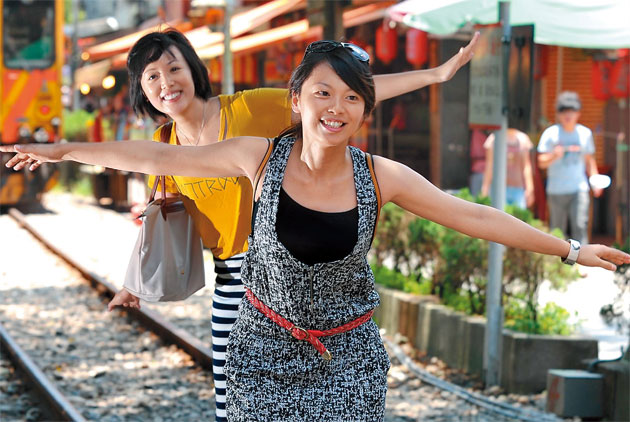2012 Golden Service Awards
Transit Hubs Sparking New Travel Vogue

Source:CW
Taiwan's high speed rail line and a highway service area earned high marks in the second CommonWealth Magazine Golden Service Awards. What's driving the trend?
Views
Transit Hubs Sparking New Travel Vogue
By Yueh-lin Ma, Ming-ling HsiehFrom CommonWealth Magazine (vol. 501 )
In a massive oval space bathed in a soft, amber hue, a group of girls carefully select bags and shoes, while middle-aged women prepare to buy souvenirs. Many others relax at tables brightened by the sun, sipping coffee and taking a break.
The venue may sound like a trendy department store, but it's actually the Qingshui Service Area on National Highway No. 3.
The facility goes far beyond offering the basic roadside necessities, such as restrooms, gas stations and restaurants. Motorists can also enjoy massages, buy essential oils, pick up handmade souvenirs and even catch an occasional photo exhibition or magic festival.
The Qingshui Service Area has long been acclaimed as a leisure landmark, graced by a main building shaped like a large sail, an ecological fish pond, and attractive night views. More than 3.8 million people stop there every year, about as many as visit the renowned National Palace Museum.
It earns the highest revenues of any of the 14 rest areas in Taiwan's national highway network, pulling in NT$630 million last year, roughly the same as a small department store.
"I have never actually seen a stop point like this in Canada before, not this big," says a 22-year-old Canadian named Ryan, visiting Taiwan for five days with his Chinese girlfriend.
Having just been to Kenting and Sun Moon Lake, they are on their way back to Taipei and are stopping at Qingshui for a meal. In Canada, most highway service areas generally have gas stations and maybe three or four restaurants. After seeing Taiwan's version, the Canadian national says effusively: "This place is like a mall, kind of. It's like a small shopping center downstairs."
Some 150 kilometers away, Breeze Group vice chairman and general manager Ichiro Oka, hands rolled into fists, walks briskly over the black and white tiled floor in the lobby of Breeze Taipei Station. There, visitors are welcomed by the bold Chinese characters for "Taipei Train Station," designed by renowned calligrapher Tong Yang-tze. The sun's rays seep through the windows, casting a golden spotlight on a young man and woman eating ice cream.
When Oka arrives at the 23-square-meter retail outlet of Uncle Tetsu's Cheese Cake – a brand from Kyushu, Japan – he sees that the line of people waiting is as long as ever and can't hold back: "This store's monthly revenues of NT$6 million is No. 1 here. I never thought it would become so popular."
Five years ago, the Breeze Group turned Taipei Railway Station's filthy, sparsely visited second floor into a popular food court. Last November, it expanded its presence, turning the station's first floor and basement into a brightly lit souvenir center and putting an end to the building's days as simply a transportation hub. It had become a top visitor destination in its own right.
"The second floor, NT$1 billion. The first floor and basement, also NT$1 billion. This year the train station alone will generate NT$2 billion in revenues for Breeze," says Oka with confidence.
Retail businesses live and die by visitor traffic, and that traffic has risen significantly in Taiwan's transportation centers in recent years because of a number of factors. The country's transportation network is growing denser by the day, reducing the distance between cities or to tourist destinations. With information widely available and Internet access convenient, consumers can easily search for insights into areas anywhere in the country, increasing their desire to travel. That interest has also been piqued by a greater yearning for leisure, good food and interpersonal contact.
![]() Travel Hub Opportunities: The New Battleground
Travel Hub Opportunities: The New Battleground
The dramatic rise in the number of trips people are taking and the fierce competition in innovating services have transformed the travel economy between northern and southern Taiwan into far more than simply satisfying the demand for transportation.
This travel and leisure market spawned by the synergistic combination of rising volume and a high density of services has in fact emerged as Taiwan's new domestic demand battleground.
The prominent role of travel in the Taiwanese service economy was reflected in CommonWealth Magazine's 2012 Golden Service Awards. Three of the top 10 places in the overall rankings were held by companies providing transportation-related services. (Table 1)
According to Ministry of Transportation and Communications statistics, average daily passenger trips by regular railway, high-speed railway, the Kaohsiung and Taipei MRT systems and highway buses all rose to record heights last year. (Table 2)
Taiwan's 6.08 million visitor arrivals from overseas also set an all-time high.
Tourism earned the country US$11.07 billion in foreign exchange in 2011, five times the after-tax income of prominent electronics vendor Delta Electronics Inc., and it may have helped steady a sluggish economy early this year. (Table 3)
While Taiwan's exports contracted by 4 percent in the first quarter, Taiwan's publicly listed tourism-related companies saw revenues rise 13 percent from January to May.
One of the key barometers that has emerged in gauging the development of a tourism and travel economy is the strength or weakness of the country's transportation services, to which foreign visitors devoted 20 percent of their overall travel spending. Taiwan has shown marked improvement in the area over the past decade.
A Tourism Bureau survey on visitors' perceptions of Taiwan in 2001 found that visitors were least impressed by "transportation conditions" in the country. Respondents commented that not only was traffic chaotic and crowded and the roads poor, but that there were too many cars and motorbikes, many of which did not abide by traffic regulations.
Nine years later, in a survey done in 2010, foreign visitors expressed a high degree of satisfaction with the transportation system, praising the convenience of domestic transportation, customs and immigration clearance at major gateways, and air services into the country (including flights, seats and destinations).
Indeed, Taiwan High Speed Rail Corporation's sterling reputation won it first place in the 2012 Golden Service Awards overall rankings. EVA Airways placed fourth, beating out prestigious rival Singapore Airlines, and the Qingshui Service Area finished a surprising 10th.
These high placings were unmistakable indications that within the overall service sector, the quality of Taiwan's transportation services has finally gained public recognition.
"Transportation is extremely important to business development. Aside from moving people and goods, it also helps talent and customers get around," says Cheng Kong-fah, an associate professor with National Chung Cheng University's Graduate School of Marketing Management. The further integration of transporation networks with the retail sector has not only created new lifestyles and values, but could also emerge as a new export opportunity for Taiwan's services, Cheng says.
![]() Highway Service Areas Models for China
Highway Service Areas Models for China
The Gukeng Service Area on National Highway No. 2, dubbed the "coffee garden street," caters especially to women. Orchids hang from the trees outside the facility and a postal box installed at the entrance enables travelers to send "happy postcards" for free.
The area's main building features a coffee section that tells the story of coffee and an ecological corridor that displays some of the sounds of birds found in Gukeng, such as the Japanese white-eye and the fairy pitta.
But what may most surprise visitors are the restrooms, with makeup areas set off by crystal curtains, and changing rooms with wooden floors.
The service counter also makes hand cream available to visitors and has security guards accompany women back to their cars after 10 p.m.
"Today, every service area is like a beautiful attraction," says Ho Hsiao-kuang, the CEO of Nan Ren Hu Entertainment, which manages the Gukeng Service Area.
Nan Ren Hu began managing highway service areas 12 years ago, and in 2007 it expanded the business beyond Taiwan to China, where it now runs 15 national highway rest stops in Shandong, Zhejiang, Fujian and Henan provinces.
More recently, Nan Ren Hu set up a joint venture with Ting Qiao (Cayman Islands) Holding Corp., the restaurant management arm of the Ting Hsin International Group, to extend Taiwan's service area experience to even more transportation hubs. Nan Ren Hu is responsible for expanding the network while Ting Qiao is in charge of operations.
The joint venture's first service area is near the Hangzhou Bay Bridge.
"In Fujian Province alone, there are already more than 2,000 kilometers of highways. There are 100,000 kilometers of highways in all of mainland China. It's developing very quickly," Ho says.
As occurred in Taiwan, China's service areas are increasingly facing the need to move beyond the basics, and they are hoping to pick up pointers from Nan Ren Hu's experience in Taiwan. In recent years, 20 Chinese delegations per year have visited service areas managed by the company on the island to strengthen their knowledge of service area management.
Taiwan's management of service areas in transportation hubs has, in fact, emerged as such a strength that other countries are looking on with admiration.
In April, at a meeting of the International Union of Railways (UIC), high speed rail companies from Japan and Europe expressed interest in the e-ticket processing and checking system developed by Taiwan High Speed Rail Corp.
To further enhance the quality of the passenger experience, the high-speed rail company has developed a ticket and seating verification device the size of a cell phone that can be continuously updated in real time. With the device in hand, railway personnel can silently check tickets aboard the trains without disturbing passengers.
"We come in contact with more than 100,000 people every day, and I hope we can build a culture that respects and cares for customers," says THSRC chairman Ou Chin-der in explaining the rationale behind the new service.
Taiwan's fiercely competitive highway service areas have developed distinct operating advantages; the high-speed rail, even without any apparent rivals, has managed to transcend traditional service models.
And with every tweak of their business models, the travel economy that these unique Taiwanese services have built is edging closer to the goal of forging an emerging power in promoting good living.
Translated from the Chinese by Luke Sabatier






